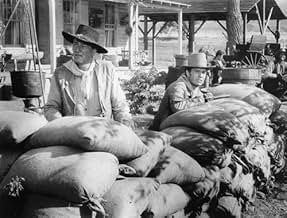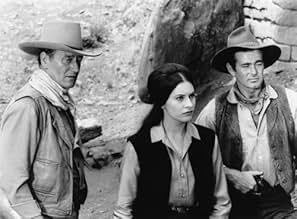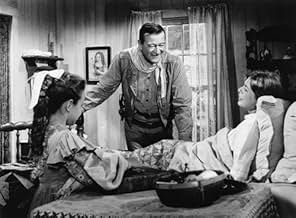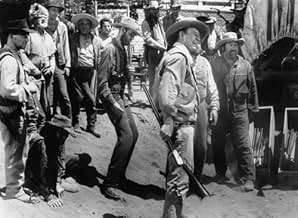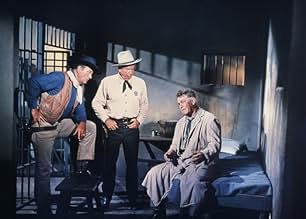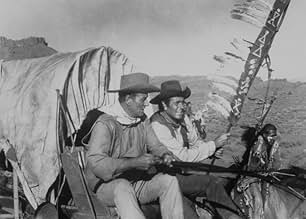El ranger de Texas Jake Cutter arresta al jugador Paul Regret, pero pronto forma equipo con él para derrotar a una banda de comerciantes de armas y ladrones renegados que trafican con los co... Leer todoEl ranger de Texas Jake Cutter arresta al jugador Paul Regret, pero pronto forma equipo con él para derrotar a una banda de comerciantes de armas y ladrones renegados que trafican con los comanches.El ranger de Texas Jake Cutter arresta al jugador Paul Regret, pero pronto forma equipo con él para derrotar a una banda de comerciantes de armas y ladrones renegados que trafican con los comanches.
- Dirección
- Guión
- Reparto principal
- Premios
- 2 premios y 3 nominaciones en total
Patrick Wayne
- Tobe
- (as Pat Wayne)
Phil Arnold
- Nervous Drunk
- (sin acreditar)
Anne Barton
- Martha Schofield
- (sin acreditar)
Steve Baylor
- Comanchero
- (sin acreditar)
Danny Borzage
- Barfly
- (sin acreditar)
Don Brodie
- Card Dealer
- (sin acreditar)
Reseñas destacadas
One of John Wayne’s best latter-day films also happened to be legendary (and versatile) director Curtiz’ last: he was ill with cancer at the time, and the star himself (who had recently tried his hands at directing for the first time with the large-scale THE ALAMO [1960]) stepped in when the latter proved too weak to work; incidentally, the two had previously collaborated on the atypical TROUBLE ALONG THE WAY (1953) which has just been released on DVD by Warners. Ironically, Wayne – who is at one time called “Big Jake” in the film – would likewise deputize as a director for the ailing George Sherman (who produced THE COMANCHEROS) on another solid Western of his entitled BIG JAKE (1971)!
Coming right in between the farcical NORTH TO THE ALASKA (1960) and the elegiac THE MAN WHO SHOT LIBERTY VALANCE (1962), it’s neither as comic as the former nor as grim as the latter, but manages to strike a good balance between the two. The film has an interesting episodic structure: Texas Ranger Wayne chasing gambler Stuart Whitman (accused of murder), Whitman meeting mystery woman Ina Balin on a boat (having slipped from Wayne’s fingers), Wayne crossing paths with psychotic arms dealer Lee Marvin (with a prominent scalp), Wayne and Whitman eventually team up to rout the Comancheros – a renegade band with their own strict code of ethics who’s in league with the Indians (they’re led by Nehemiah Persoff, incidentally Balin’s father).
Wayne and Whitman work well together: the latter eventually co-starred in a similar Fox Western, RIO CONCHOS [1964], which is yet to be released on DVD – but, as it happens, has just been shown on Italian TV and I taped it for an instant reappraisal; Marvin has a brief but showy role, Persoff makes a fine villain, and Balin’s strong character is unusual for a Western (though she eventually reforms for the sake of Whitman!). There’s also a good supporting role for Wayne’s son, Patrick; and, while I don’t know how much say Curtiz had in casting the film, it was great to see two alumni of his in nice bits – Henry Daniell (from THE SEA HAWK [1940]) and Guinn “Big Boy” Williams (from DODGE CITY [1939]).
As can be expected, THE COMANCHEROS features plenty of well-staged action sequences (including a climactic bout in which all the various parties involved clash) – all set to a rousing Elmer Bernstein score, fresh from THE MAGNIFICENT SEVEN (1960). Watching the film got me thinking about another good Wayne Western from this later period which I haven’t watched in over 20 years – THE WAR WAGON (1967; incidentally, the last of 3 collaborations with Kirk Douglas) – which is actually upcoming on R1 DVD as part of a Universal “John Wayne Screen Legends” set...
Coming right in between the farcical NORTH TO THE ALASKA (1960) and the elegiac THE MAN WHO SHOT LIBERTY VALANCE (1962), it’s neither as comic as the former nor as grim as the latter, but manages to strike a good balance between the two. The film has an interesting episodic structure: Texas Ranger Wayne chasing gambler Stuart Whitman (accused of murder), Whitman meeting mystery woman Ina Balin on a boat (having slipped from Wayne’s fingers), Wayne crossing paths with psychotic arms dealer Lee Marvin (with a prominent scalp), Wayne and Whitman eventually team up to rout the Comancheros – a renegade band with their own strict code of ethics who’s in league with the Indians (they’re led by Nehemiah Persoff, incidentally Balin’s father).
Wayne and Whitman work well together: the latter eventually co-starred in a similar Fox Western, RIO CONCHOS [1964], which is yet to be released on DVD – but, as it happens, has just been shown on Italian TV and I taped it for an instant reappraisal; Marvin has a brief but showy role, Persoff makes a fine villain, and Balin’s strong character is unusual for a Western (though she eventually reforms for the sake of Whitman!). There’s also a good supporting role for Wayne’s son, Patrick; and, while I don’t know how much say Curtiz had in casting the film, it was great to see two alumni of his in nice bits – Henry Daniell (from THE SEA HAWK [1940]) and Guinn “Big Boy” Williams (from DODGE CITY [1939]).
As can be expected, THE COMANCHEROS features plenty of well-staged action sequences (including a climactic bout in which all the various parties involved clash) – all set to a rousing Elmer Bernstein score, fresh from THE MAGNIFICENT SEVEN (1960). Watching the film got me thinking about another good Wayne Western from this later period which I haven’t watched in over 20 years – THE WAR WAGON (1967; incidentally, the last of 3 collaborations with Kirk Douglas) – which is actually upcoming on R1 DVD as part of a Universal “John Wayne Screen Legends” set...
This is an entertaining John Wayne movie, with a good cast. It may not rank right up there with the great John Ford westerns and other films The Duke was in, it nevertheless presents the essence of John Wayne during this phase of his career (call it "mid-career"), and actually foreshadows the John Wayne we would see for the rest and remainder of his career. This is a high quality, well-made film --probably a testament Michael Curtiz's directing-- and the quality of the film, and its obvious production values, are evident throughout. One way this shows itself is, although the movie was made in 1961, it really seems and feels like a much newer movie, made 5 or even 10 years later than it was. I don't know what to attribute that quality to other than simply it being a well-made film.
In a way the movie is three movies, consisting of three separate but connected story arcs, any or each of which could have been beefed up and expanded into movies unto themselves. The story is thusly layered with complexity, which keeps it all interestingly moving along apace, never bogging down. It is also however the source of the movie's only real flaw. And that flaw is, as other reviewers have noted, the movie's presentation of a dubious and flawed historical chronology. And it isn't just little anachronisms like repeating rifles out of time. There is a complete confusion of historical eras and historical settings. Even though the story is set in 1843, its time seems to vacillate throughout, in one arc staying true to the story it is or purports to be, a story set in the antebellum south, but then jumping in another arc to a story appearing to be more similar to the further-western and decades later Indian wars, circa the 1870s. It seems as if there was lot of trouble deciding which of those two kinds of stories the movie was telling, a story about events in the antebellum south or a shoot-em-up story of the western Indian wars. It is likely a problem of scriptwriting, having had numerous "treatments" or rewrites by more than one writer, and those seams show. My guess is ultimately director Michael Curtiz and producer George Sherman must have decided that the typical ticket-buyers for this movie would be fans of John Wayne westerns, and that target audience would not be comprised of history majors or even history buffs, or be ones to get hung up on historical details, so they just let the historical flaws slip through.
There is one unintentionally funny moment in the movie. About mid-way through, watch for the blood-curdling scream by the bed-ridden lady (Joan O'Brien?) at the outpost when she looks out the window and sees the supposed Indian raiders crossing the river. It is truly a classic and world-class movie scream. I wonder how many takes that took.
One of the movie's three story arcs features Lee Marvin. This is a pre-Cat Ballou, pre-Dirty Dozen Lee Marvin who at this point in his career wasn't really yet a bigtime Hollywood household name, at least not like he would later become. Marvin turns in a marvelous over-the-top performance as a gun-dealing rapscallion, in my opinion flat-out stealing every scene he's in. That's no small feat, considering in all of his scenes he was playing directly off against John Wayne, who almost fades into the woodwork in the comparison. Actually Wayne sublimates himself quite well. He knew how to be a team player, and the chemisrty between Wayne and Marvin is good. Unfortunately this story arc is really nothing much more than a side-story than anything else, so Marvin's role is quite limited. Too bad. I would've liked to have seen a lot more of Marvin in this film. It would have been a better movie for it.
Lee Marvin, John Wayne and Marvin appeared together again two years later in John Ford's Donovan's Reef, with Marvin again playing a lesser role.
This movie pops up regularly on the Encore Westerns channel. I've seen it there about 5 times over the last 6 months. Watch for it.
In a way the movie is three movies, consisting of three separate but connected story arcs, any or each of which could have been beefed up and expanded into movies unto themselves. The story is thusly layered with complexity, which keeps it all interestingly moving along apace, never bogging down. It is also however the source of the movie's only real flaw. And that flaw is, as other reviewers have noted, the movie's presentation of a dubious and flawed historical chronology. And it isn't just little anachronisms like repeating rifles out of time. There is a complete confusion of historical eras and historical settings. Even though the story is set in 1843, its time seems to vacillate throughout, in one arc staying true to the story it is or purports to be, a story set in the antebellum south, but then jumping in another arc to a story appearing to be more similar to the further-western and decades later Indian wars, circa the 1870s. It seems as if there was lot of trouble deciding which of those two kinds of stories the movie was telling, a story about events in the antebellum south or a shoot-em-up story of the western Indian wars. It is likely a problem of scriptwriting, having had numerous "treatments" or rewrites by more than one writer, and those seams show. My guess is ultimately director Michael Curtiz and producer George Sherman must have decided that the typical ticket-buyers for this movie would be fans of John Wayne westerns, and that target audience would not be comprised of history majors or even history buffs, or be ones to get hung up on historical details, so they just let the historical flaws slip through.
There is one unintentionally funny moment in the movie. About mid-way through, watch for the blood-curdling scream by the bed-ridden lady (Joan O'Brien?) at the outpost when she looks out the window and sees the supposed Indian raiders crossing the river. It is truly a classic and world-class movie scream. I wonder how many takes that took.
One of the movie's three story arcs features Lee Marvin. This is a pre-Cat Ballou, pre-Dirty Dozen Lee Marvin who at this point in his career wasn't really yet a bigtime Hollywood household name, at least not like he would later become. Marvin turns in a marvelous over-the-top performance as a gun-dealing rapscallion, in my opinion flat-out stealing every scene he's in. That's no small feat, considering in all of his scenes he was playing directly off against John Wayne, who almost fades into the woodwork in the comparison. Actually Wayne sublimates himself quite well. He knew how to be a team player, and the chemisrty between Wayne and Marvin is good. Unfortunately this story arc is really nothing much more than a side-story than anything else, so Marvin's role is quite limited. Too bad. I would've liked to have seen a lot more of Marvin in this film. It would have been a better movie for it.
Lee Marvin, John Wayne and Marvin appeared together again two years later in John Ford's Donovan's Reef, with Marvin again playing a lesser role.
This movie pops up regularly on the Encore Westerns channel. I've seen it there about 5 times over the last 6 months. Watch for it.
The scene where the Duke Wayne character (Texas Ranger Jake Cutter) meets the Joan O'Brien character (Melinda) after a long time away. The powerful Elmer Bernstein soundtrack combined with the beautiful cinematography of the Old Homestead make this scene one of the best of any Western. Also the scenes where The Duke is jesting with his real life son ("we didn't beat this boy enough when he was growing up") and where he lovingly takes his real life daughter in his arms (scene at Melinda's small farm) are first rate. I give the movie a 9 out of 10.
Never a huge fan of John Wayne, I watched this because I knew it was the last film by Michael Curtiz (he died soon after filming was completed). I thought it would be an average diversion.
I was pleasantly surprised. This movie is a lot of fun, as long as you do not try to make sense of it, and do not take it seriously.
Beautiful landscapes, a great score by Elmer Bernstein, a terrific, performance by Wayne (who looks like he's having the time of his life surrounded by his real-life children on the set) and a show stealing role by Lee Marvin, who looks as though he has a bunch of "Silly Putty" sitting on top of his head (not the best make-up job, guys).
I'm so glad I invested the time to watch this. You will be too.
I was pleasantly surprised. This movie is a lot of fun, as long as you do not try to make sense of it, and do not take it seriously.
Beautiful landscapes, a great score by Elmer Bernstein, a terrific, performance by Wayne (who looks like he's having the time of his life surrounded by his real-life children on the set) and a show stealing role by Lee Marvin, who looks as though he has a bunch of "Silly Putty" sitting on top of his head (not the best make-up job, guys).
I'm so glad I invested the time to watch this. You will be too.
I really enjoy this film, though it's more about how much I love the sights in the American Southwest, and William Clothier's Cinemascope photography of locals in Utah and Arizona is simply stunning here, and the wonderful Elmer Bernstein score, and less to do with the conventions of the Western genre in general and John Wayne movies in particular. Both had become pretty stale by the time this picture was made. As a 'serious' Western it can be dismissed; it's about as historically accurate as "Blazing Saddles" and I don't know what's supposed to look worse, the scalped head make-up Lee Marvin (who practically steals the film) wears or the wig-pieces Wayne sports. However, this forty-year-old movie plays as better entertainment than most movies made today. It's hardly cynical, tries to reinforce ideas of right and wrong, and knows it's not to be taken seriously anyway. You can also tell that everyone seems to be having a very good time making this movie. It's also the last of more than 150 films directed by Michael Curtiz (though Wayne had to direct a lot of it himself when Curtiz fell ill [Curtiz died shortly after filming ended]). A beautiful letterboxed transfer of this movie was done for laserdisc in 1993. It also featured commentary by stars Stuart Whitman, Patrick Wayne, Michael Ansara and Nehemiah Persoff, as well as production stills, script pages, posters and lobby cards. Somebody at Fox at the time thought the movie deserved this 'Collector's Edition' treatment, so I can only hope that person is still there and that this will be replicated on DVD soon.
¿Sabías que...?
- CuriosidadesGeorge Sherman produced this film, and Michael Curtiz directed it. During much of the shooting, Curtiz was seriously ill: he died of cancer shortly after the film's release. On the days when Curtiz was too ill to work, John Wayne took over direction. When the film was completed, he told the studio that he did not want credit as co-director and insisted that Curtiz's name alone appear as director. Wayne performed the same function in 1971 on "El gran Jack (1971)," which was directed by Sherman, who took ill during production. Wayne directed the film on the days when Sherman couldn't and again insisted that he not receive co-director credit.
- PifiasThe guns used in the movie are Colt Single Action model 1873 revolvers, look-alike Henry lever-action model 1860 rifles, and Winchester model 1892 lever-action rifles. The only correct period guns are the single-shot percussion-cap dueling pistols used in the opening scene.
- Citas
[while Regret and Cutter are tied up as prisoners]
Paul Regret: I wonder if they know how much trouble they're in.
- Versiones alternativasWhen originally released theatrically in the UK, the BBFC made cuts to secure an 'A' rating. When released on home video in 1988, the BBFC made cuts of 11 seconds to remove shots of horse-falls to secure a 'PG' rating. For the DVD release, the BBFC made cuts of 8 seconds in 2003 to remove similar shots of horse-falls resulting in a 'PG' rating. To date (December 2014), the film has not been released fully uncut on UK media.
- ConexionesFeatured in Hollywood Remembers Lee Marvin (2000)
- Banda sonoraThe Comancheros
Music & Lyrics by Tillman B. Franks (as Tillman Franks)
Selecciones populares
Inicia sesión para calificar y añadir a tu lista para recibir recomendaciones personalizadas
Detalles
Taquilla
- Presupuesto
- 4.260.000 US$ (estimación)
- Duración1 hora 47 minutos
- Color
- Relación de aspecto
- 2.35 : 1
Contribuir a esta página
Sugerir un cambio o añadir el contenido que falta

Principal laguna de datos
By what name was Los comancheros (1961) officially released in India in English?
Responde
